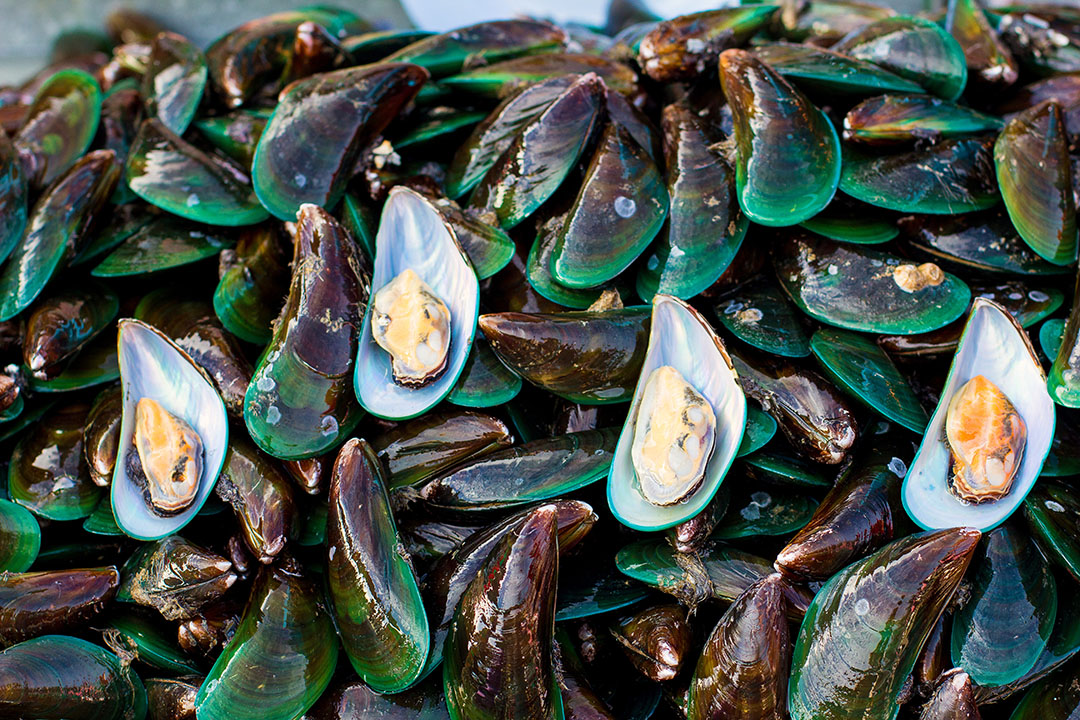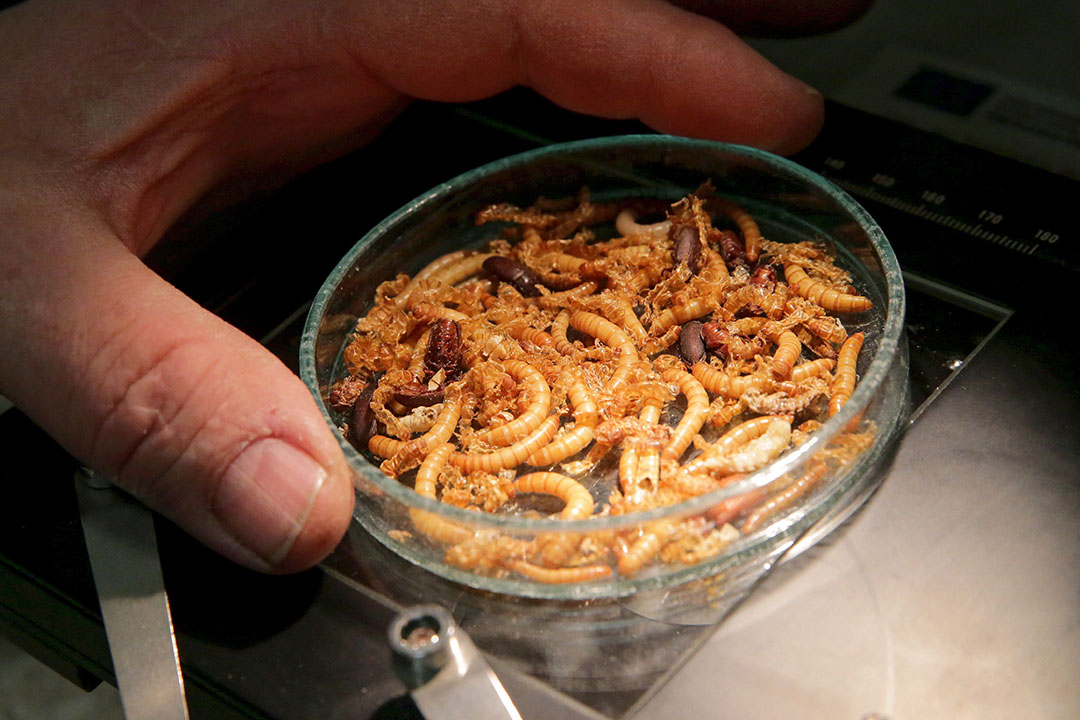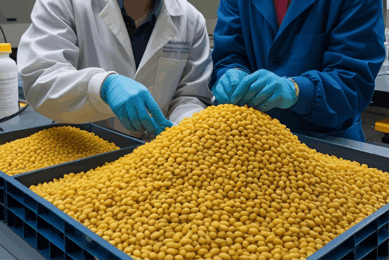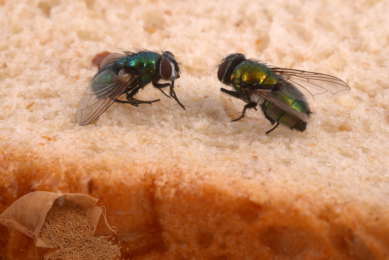What are the protein feedstuffs of the future?

A recent study evaluated the potential of feeding several sustainable and novel feed ingredients to weaned pigs and poultry. Although the results seem promising, applying these novel proteins requires thinking out of the box.
Protein is an essential nutrient for the productivity of farm animals. Soy and fishmeal are 2 of the main ingredients used to meet animals’ protein requirements in feed rations because they provide substantial levels of protein and essential amino acids. However, fluctuating prices as well as deforestation and greenhouse gas emissions related to the production and transport of soy, as well as overfishing, have increased the need for alternative protein-rich feed ingredients.
What makes an alternative protein source ideal?
Ideally, these alternative protein sources should, besides providing protein, in particular essential amino acids, have minimal negative impacts on the environment. Obtaining high-quality protein locally can be a challenge in many northern European countries, where climate conditions limit the production of protein-rich crops. In Denmark, for example, several experiments have been carried out using starfish, mussels and insects as protein alternatives for non-ruminant production animals.
Proteins of the future
These raw materials are all potentially available locally, i.e., within Denmark but also in other coastal areas. The starfish and mussels (blue mussel) used in these experiments originate from natural bodies of water.
Starfish
Starfish, which are a plague in mussel farms, can cause losses in mussel production. This is why wild starfish are often removed from mussel cultivation sites. This creates an underutilised by-product of mussel farming which is suitable for consumption by animals.
Mussels
The mussels used for animal feed can be those not suitable for use as food (usually due to their size). Alternatively, as mussels filtrate nitrogen (N) and phosphorus (P) out of the water, mussels cultivated in order to mitigate eutrophication may be used. This creates a circular stream of nutrients in which excess N and P from land-based activities are recycled back into the food chain.
Insects
Moving from the water to land, insects are also a potential novel protein source. Insects are of particular interest because of their ability to utilise waste and rest materials. Moreover, the physical rearing of insects requires very little (arable) land. Indirectly, however, the substrate provided to insects may have some arable land use associated with it. For black soldier fly and yellow mealworm large-scale production sites have been established and these insects are thus often used in scientific research. The lesser mealworm is another potential candidate for feed with established production. A prerequisite for using ingredients in feed is their potential to supply nutrients for growth without growth inhibiting elements. In this respect, the protein concentration and matching the ingredients’ amino acid (AA) profile with the animals’ requirements are fundamental.
Mussel meal – nutrition & preformance
Mussel meal, which is derived from mussel meat, can have a crude protein (CP) concentration of between 60-70% dry matter (DM), which is comparable or slightly below the protein concentration often observed in fishmeal. Besides its protein concentration, its similar essential amino acid profile makes mussel meal a potential substitute for fishmeal. Indeed, a high ileal digestibility of 83% was found several years ago when feeding ileal cannulated pigs with mussel meal. It has previously been shown that laying hen performance in experimental facilities is maintained when 4-12% mussel meal is included in diets, thus totally replacing fishmeal. Similarly, broilers and finishing pigs have been found to perform well on diets containing mussel meal. Additionally, the dietary provision of mussel meal can enhance the yolk colour of eggs due to the presence of carotenoids. This colouration potential may differ depending on carotenoid uptake as the mussel grows.

Processing of mussels
Recently, the focus has been on using different processing methods for the production of mussel meal. A drawback in the production of meal from mussel meat is the high − and expensive − input of energy and water for boiling to remove shells. Another less energy demanding form of mussel meal, i.e. filtrated mussel meal containing shell particles, has therefore been experimentally evaluated. As the shell is not entirely removed, salt and shell particles heighten ash and consequently lead to a lower protein concentration in shell-reduced mussel meal.
Study compared fishmeal, deshelled & shell-reduced mussel meal
Group housed (6 pens) laying hens at a commercial farm were fed diets containing either 3% fishmeal, 5% deshelled mussel meal or 6% shell-reduced mussel meal from 23 weeks of age (after egg laying had begun). Laying hens were held according to organic regulations. At several hen ages, 25 eggs were collected for quantitative analysis of the egg quality. Shell strength was maintained when feeding either type of mussel meal compared with fishmeal. Feeding shell-reduced mussel meal enhanced the orange colour of the yolks compared with fishmeal. Furthermore, the presence of omega-3 fatty acids in deshelled mussel meal led to enhanced deposition of omega-3 in eggs. Nevertheless, feeding shell-reduced mussel meal reduced egg weight (by 2 grams on average), which coincided with lower bird liveweight gain. The high salt concentration in shell-reduced mussel meal was probably the reason for this.
Starfish meal
With an average CP concentration of 39% DM, starfish meal is generally less rich in protein compared to fishmeal. Starfish meal contains considerable levels of essential amino acids, although most are slightly lower than the levels found in fishmeal. Still, as with mussel meal, protein from starfish meal has been found to be well digested by pigs, with a standardised ileal digestibility of 80%. Meal from starfish can, however, contain from 20% up to over 50% ash. This highly variable ash concentration is attributable to fluctuations in nutrient composition during the starfish’s reproductive cycle. In starfish from Danish waters, a study on seasonal variation has shown that proper choice of harvesting time maximises protein and minimises ash content. Despite its high ash content, starfish meal can replace fishmeal and maintain the growth performance of growing pigs and laying hens. Nevertheless, inclusion of more than 7.5% starfish meal has been shown to reduce the growth performance of growing pigs. The is due to excess calcium from starfish meal reducing the availability of phosphorus.

Insect meal
Many experiments have been carried out using different insect types in pig and poultry nutrition. On average, insect meals contain around 60% CP. Although protein concentrations can vary with insect type, rearing conditions and processing (e.g., defatting). Insect meals are generally a good substitute for soybean meal in terms of essential amino acids. However, levels of cysteine − an important limiting amino acid in insect meal − tend to be lower. The substrate used for rearing insects affects their nutrient composition. As a result, the controlled production of insects offers interesting possibilities for balancing nutrient composition.
Many studies have successfully (partially) replaced soy with black soldier fly or yellow mealworm in diets for pigs and poultry. A general consensus in these studies is that too high an inclusion (above approximately 10% of the diet) limits feed efficiency. This is probably due to chitin, a cellulose-like fibre that makes up the exoskeleton of insects, limiting the digestibility of protein.
Study: Replacing soybean meal with insect meal
In a study using group-housed conventional Ross 308 broilers under experimental conditions, lesser mealworm, black soldier fly and yellow mealworm were fed at a 10% inclusion rate. Replacing soybean meal with insect meal was complicated due to low cysteine concentrations. Initially, but not overall, reduced feed intake led to reduced liveweight gain when yellow and lesser mealworm were fed to broilers. However, it is uncertain whether this is an effect of the insect meal or an effect of differences in diet composition. Feeding black soldier fly led to similar growth performance compared to a control diet. Interestingly, in particular in the grower phase, feed efficiency was improved when feeding lesser mealworm.
Thinking outside of the box
These ingredients are only a few of those with the potential to partially replace commonly used protein-rich ingredients without compromising growth performance. However, solely being able to maintain good growth performance is not the only prerequisite for the use of ingredients. The adaptation of these alternative and locally produced feed ingredients also depends on the available quantity and the cost-effectiveness of incorporating them in feed rations. Moreover, to prevent shifting environmental concerns related to soy and fishmeal, it will be important to understand the effects of producing these feedstuffs on biodiversity, land and water quality, and greenhouse gas emissions. This will ensure the long and fruitful use of these alternative ingredients. It is certain that future provision of novel proteins in feed will require thinking outside of the box. The use of co-products, enhancing quality and the availability of locally available ingredients plus the establishment of new production forms are among the various methods of obtaining novel proteins in Denmark and in Europe as a whole.











